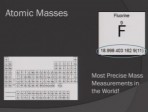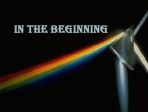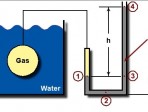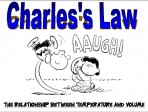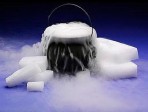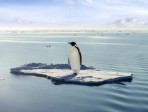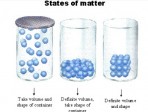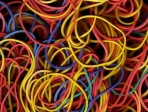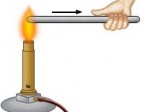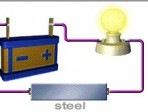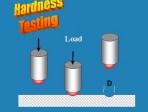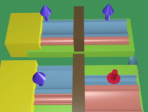 00:01:00
00:01:00
Graphene
A magnetic tunnel junction is a device with two magnets separated by a very thin non-magnetic barrier. The two magnets can be aligned parallel or antiparallel. The electrical resistance of this devices depends on the alignment. This video illustrates....
More details | Watch now 00:09:00
00:09:00
The dynamics of a spinning chair
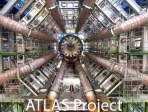 00:11:00
00:11:00
askFSU 1 : speed of light, tachyons, solar sails, and black holes
Joining Philip Schlenoff is Dr. Jeff Owens, from the Physics department at Florida State University, to answer some physics and astrophysics-related questions!
More details | Watch now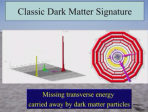 01:03:00
01:03:00
The Long Road to the Higgs Boson – and Beyond
The discovery of the Higgs boson at CERN’s LHC accelerator in 2012 by the ATLAS and CMS collaborations was the culmination of a decades-long search that had started in 1964 with the proposal of this unique particle, a signature of the origin of the....
More details | Watch now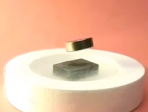 00:10:00
00:10:00
Superconductivity
This video shows a terrific selection of superconducting demonstrations and explanations.
More details | Watch now-148x112.jpg) 00:29:00
00:29:00
hyperfine interactions
30-minute lecture about the physics of hyperfine interactions, and about how to calculate hyperfine interactions by the WIEN2k DFT code
More details | Watch now 01:04:00
01:04:00
Communicating with light
Most of the data we generate and receive (whether emails, tweets, videos or mobile calls) are now carried by optical fibres, which use light to transmit vast quantities of information over trans-oceanic distances. The use of hundreds of wavelengths ....
More details | Watch now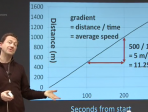 00:08:00
00:08:00
Longboard data analysis
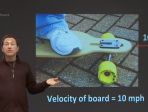 00:04:00
00:04:00
Longboard physics
A few (surprising?) thoughts on how the wheels on a longboard or skateboard actually move.
More details | Watch now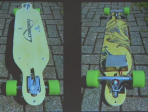 00:07:00
00:07:00
The Longboard – speedometer
Jonathan describes his adventures with a longboard and some different methods of making a speedometer for it.
More details | Watch now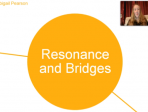 00:03:00
00:03:00
Resonance and Bridges
Abbie describes why bridges must be designed to counteract the effects of unwanted vibrations.
More details | Watch now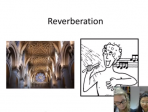 00:06:00
00:06:00
Concert Hall Acoustics
Physics' students Rosie & Carine explain the physics behind concert hall acoustics.
More details | Watch now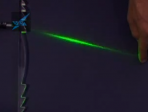 00:05:00
00:05:00
The Fresnel Lens
Early lighthouses used coil and wood fires before moving on to gas and then electricity powered lights. Massive improvements took place by using a lens system around the light. The development of the Fresnel lens brought what we now regard as the....
More details | Watch now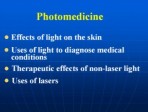 01:00:00
01:00:00
A Little Light Relief
Light, particularly sunlight, is believed to be good for our health. Many ancient civilisations even attributed it with mystical healing powers.Renowned for his entertaining lectures, Professor David Phillips, President of the RSC, uses his expertise....
More details | Watch now 01:15:00
01:15:00
The Nuclear Debate
New carbon targets requires reducing emissions of greenhouse gases by 50% for 2030. This house believes that it will be impossible to meet the emissions reductions required to fulfil these obligations without the use of nuclear power. Taking the pr....
More details | Watch now 00:04:00
00:04:00
Real Gases
 00:51:00
00:51:00
Music, architecture and acoustics in Renaissance Venice: Recreating lost soundscapes
During the Renaissance in Venice, composers such as the Gabrieli and Moneverdi created some of their greatest masterpieces for performance in the great churches on festive occasions. But what would the music have sounded like, given its complexity an....
More details | Watch now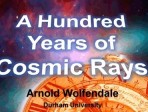 00:58:00
00:58:00
The Centenary of the Discovery of Cosmic Rays: the End of the Beginning
Sir Arnold Wolfendale FRS is Emeritus Professor of Physics at the University of Durham, and former Astronomer Royal. In 1912, Victor Hess embarked on a perilous balloon ascent and discovered the 'Cosmic Radiation', actually a beam of atomic particles....
More details | Watch now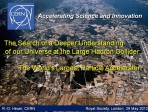 01:02:00
01:02:00
The search for a deeper understanding of our universe at the Large Hadron Collider
With the start of the Large Hadron Collider (LHC) at CERN, particle physics entered a new era. The LHC will provide a deeper understanding of the universe and the insights gained could change our view of the world, and the lecture will present some o....
More details | Watch now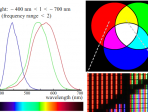 00:12:00
00:12:00
The eye and colour vision
The physics of the eye, its performance and colour vision: refraction and accommodation; photoreceptors and resolution; compromises in visual performance.
More details | Watch now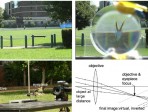 00:11:00
00:11:00
Geometrical optics
On scales much bigger than the wavelength, rays explain the behaviour of interfaces, mirrors, lenses, optical instruments, including telescopes and microscopes.
More details | Watch now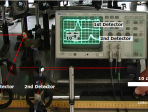 00:12:00
00:12:00
The nature of light
White light comprises colours in the visible spectrum. The electromagnetic spectrum. Speed of light. Young's experiment and waves. Quanta and photons.
More details | Watch now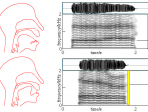 00:11:00
00:11:00
Human Sound
Sound is produced in the larynx; filtering it in the vocal tract produces formants and phonemes. The acoustics, mechanics and some neurobiology of hearing. Pitch perception.
More details | Watch now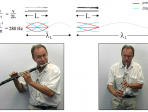 00:09:00
00:09:00
Standing waves
Reflecting waves gives standing waves, which can be resonances. Standing waves on strings and in pipes and plates.
More details | Watch now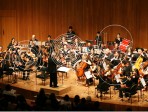 00:08:00
00:08:00
Interference and consonance
Superposing waves with different frequencies gives beats and Tartini tones. Removing beats gives consonance. Tuning consonances gives temperament.
More details | Watch now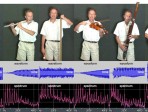 00:09:00
00:09:00
Quantifying sound
Frequency, amplitude, envelope and spectrum affect pitch, loudness and timbre. All are discussed and quantified here.
More details | Watch now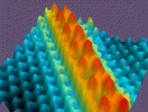 00:17:00
00:17:00
How can we see atoms ?
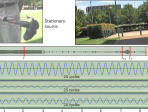 00:10:00
00:10:00
The Doppler effect
Moving either source or receiver produces a frequency shift called the Doppler effect, which we measure and analyse.
More details | Watch now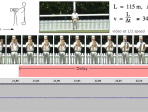 00:09:00
00:09:00
Sound
Sound is a longitudinal wave of variations in pressure and density. We derive and measure its speed.
More details | Watch now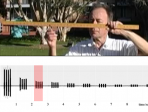 00:06:00
00:06:00
Travelling waves II
The wave equation and its physical origin. Power in a wave and its relation to intensity in radiation.
More details | Watch now 00:12:00
00:12:00
Color Theory
For my project I am giving a brief history of color theory with emphasis on how science and color theory have interacted. I focus on aspects like primary colors, how color is perceived, and the artists who were at the forefront of color and design. I....
More details | Watch now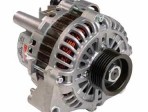 00:09:00
00:09:00
Magnetism and Electricity
This presentation reviews how magnets work and their uses in the world today. It also explains how magnets and electricity are related and what future inventions could come from using magnets.
More details | Watch now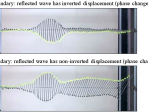 00:07:00
00:07:00
Travelling waves I
In an extended medium, inertia and a restoring force can lead to waves, which reflect at boundaries, either erect or inverted.
More details | Watch now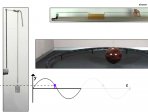 00:09:00
00:09:00
Oscillations
Inertia and restoring forces can, with low friction or damping, lead to oscillations and resonance. We analyse the mechanics of vibrations.
More details | Watch now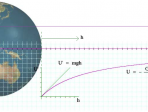 00:12:00
00:12:00
Gravity
The inverse square law explains planetary motion - and apples falling. Newton's law, measuring G, calculating orbits.
More details | Watch now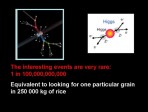 00:41:00
00:41:00
Particle Physics and the Mysteries of the Early Universe
Dr Cristina Lazzeroni, a Royal Society University Research Fellow from the University of Birmingham, reveals the secrets of the world's largest accelerator, the Large Hadron Collider and how the LHC experiments hope to answer big questions about the ....
More details | Watch now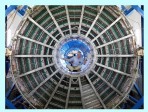 01:10:00
01:10:00
The LHC: largest experiment and smallest particles
The LHC is the most powerful particle accelerator ever built. It is capable of recreating the very energetic conditions last seen in the universe a billionth of a second after the Big Bang, and allows particle physicists to study the fundamental ingr....
More details | Watch now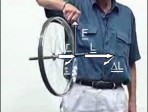 00:10:00
00:10:00
Rotation
Torques produce angular acceleration, moment of inertia 'resists' it. Rotational kinetic energy and angular momentum.
More details | Watch now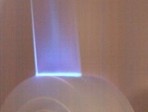 00:09:00
00:09:00
Sticky tape X-rays
Peeling sticky tape emits energy that extends into the X-ray regime, reports a study in Nature. The research provides evidence for a phenomenon that was first observed more than 50 years ago.nnIt is well known that unwinding sticky tape produces spar....
More details | Watch now .....
.....
Dark Matter, Dark Energy
Smoot's Nobel Prize was awarded for his analysis of that whisper from the Big Bang, the cosmic microwave background radiation. Today he hopes CERN's data will again transform our understanding of the universe. Young scientists Bilge Demirkoz and Benj....
More details | Watch now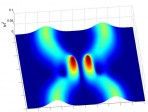 00:06:00
00:06:00
The Quantum Lattice
Awarded a Nobel Prize for using lasers to control and cool atoms, producing the Bose-Einstein condensation, Bill Phillips is eager to hear about new theories from young scientists like Hannah Venzl. An exciting dialogue develops between them on a boa....
More details | Watch now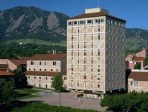 00:06:00
00:06:00
Fibre and Sunlight
Fine tuning the frequencies of light gave John Hall a Nobel Prize, and helped transform the fields of precision measurement and information transmission. Iris Choi and Andrei Ghicov are young scientists excited by the ways physics can change our worl....
More details | Watch now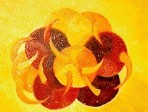 00:06:00
00:06:00
Abolishing Time?
David Gross's Nobel Prize was for work on the 'strong' force which acts between quarks inside the atom. Now he works on string theory, hoping to understand how all the forces of nature could be united. He believes the next steps may involve throwing ....
More details | Watch now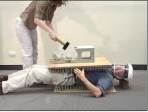 00:10:00
00:10:00
Momentum
p=mv. If external forces are zero, momentum is conserved. In collisions, energy may be conserved (elastic) or not (inelastic).
More details | Watch now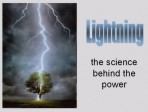 00:12:00
00:12:00
The Nature and Physics of Lightning
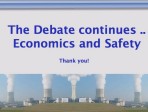 00:07:00
00:07:00
Nuclear Power in the United States
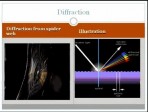 00:07:00
00:07:00
Diffraction and Fourier Transforms
 00:10:00
00:10:00
Why can’t we see atoms?
John talks about diffraction and the limits it puts on our ability to image atoms. Can we make an electron-microscope without lenses?
More details | Watch now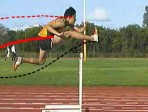 00:08:00
00:08:00
Centre of mass
In finite objects, the total external force equals the total mass times the acceleration of a point called the centre of mass.
More details | Watch now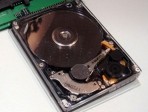 00:06:00
00:06:00
Improving your Memory
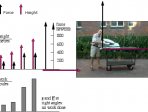 00:10:00
00:10:00
Energy and power
The total work done on an object equals the increase in its kinetic energy. For conservative forces, we can define potential energy.
More details | Watch now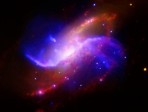 01:28:00
01:28:00
The Physics of Angels and Demons
Professor Harrison Prosper of FSU Physics Department looks at the science behind the recently released movie 'Angels and Demons', starring Tom Hanks and based upon a Dan Brown novel. Prof. Prosper discusses topics such as antimatter, dark matter, dar....
More details | Watch now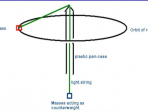 00:06:00
00:06:00
Centripetal force – how do we measure it?
A short video showing a simple classroom method of checking the way in which this force is related to mass, speed and radius.
More details | Watch now 00:14:00
00:14:00
Going round in circles – how do we do it?
A presentation showing both the ideas about centripetal force and a simple classroom method of checking the way in which this force is related to mass, speed and radius.
More details | Watch now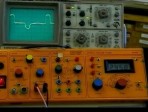 00:05:00
00:05:00
Measuring the speed of pulses
A short clip showing the experimental measurement of the speed of electrical pulses in a cable - a large fraction of the speed of light.
More details | Watch now 00:09:00
00:09:00
Measuring the speed of sound
A presentation showing how to measure the speed of sound over a short distance on a laboratory table.
More details | Watch now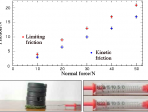 00:10:00
00:10:00
Weight and contact forces
Carefully distinguish mass and weight. Hooke's law quantifies deformation. Contact forces have normal and frictional components.
More details | Watch now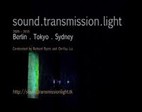 00:05:00
00:05:00
Light Beam
Light is reflected off a flexible shiny surface fixed to the end of a plastic tube. When one speaks into the tubes sound vibrations pass down the tube and make the surface vibrate. The reflected light is therefore sent off from the surface in a con....
More details | Watch now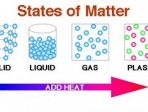 00:04:00
00:04:00
Temperature and States of Matter
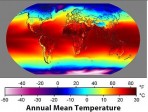 00:10:00
00:10:00
Temperature Scales
John Murrell explains scales and colour changes with temperature, boiling and melting,
More details | Watch now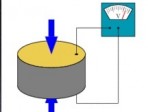 00:03:00
00:03:00
Piezoelectricity
Some minerals such as quartz can produce electricity simply by squeezing or bending them - these are called piezoelectric crystals. Here is a simple and cheap demonstration you can do.
More details | Watch now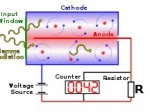 00:02:00
00:02:00
The Geiger Counter
Although essentially a very simple device the Gieger Counter is an exquisitely sensitive detector of ionising radiation. It can detect a single particle. Here we demonstrate its use in detecting radiation from minerals and describe in simple terms ho....
More details | Watch now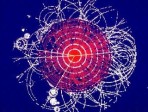 00:08:00
00:08:00
The Quest for The Higgs Particle
A Breathtaking Journey into the Innermost Structure of our Universe. Runner up: Best use of Animation and Best Short Documentary for the 2002 International Festival of Cinema and Technology.
More details | Watch now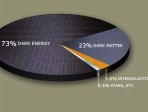 00:03:00
00:03:00
The Mystery of the Missing Mass
Dr Tara Shears explains why scientists are convinced that Dark Matter exists and how a new experiment called the Large Hadron Collider might finally tell us exactly what this mysterious missing mass is made of.
More details | Watch now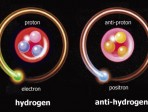 00:03:00
00:03:00
The Matter with AntiMatter
If equal amounts of matter and anitmatter were created at the birth of the universe then why does our universe seem to be made almost entirely from matter? Dr Tara Shears tells us how this mystery could be explained by the Large Hadron Collider exper....
More details | Watch now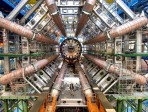 00:04:00
00:04:00
Big Bang – a tour of the Large Hadron Collider
Dr Brian Cox takes us on a tour of the Large Hadron Collider where the conditions moments after the Big Bang are to be recreated.
More details | Watch now 00:04:00
00:04:00
Sizing Things Up
Dr Tara Shears explains that one of Science's greatest achievements is to have accurately measured everything from the width of the universe to the diameter of a quark. This film features an animated zoom in from the universe to the heart of a hydrog....
More details | Watch now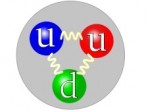 00:14:00
00:14:00
The Building Blocks of Matter
The Large Hadron Collider at CERN is the biggest science experiment ever built. Scientists from all over the world are heading to CERN with the aim of recreating particles from the beginning of the universe. Dr Brian Cox takes us on a scientific jour....
More details | Watch now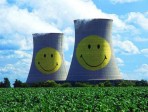 01:00:00
01:00:00
Nuclear Power Plant Safety – What’s the Problem?
A significant proportion of our electricity is generated by thermonuclear reactions. The dangers attached to these processes and the radioactive products are well known and publicised. Much less well known are the measures taken to ensure that the hi....
More details | Watch now 00:57:00
00:57:00
How X-rays cracked the structure of DNA
An elegantly simple optical diffraction demonstration with an inexpensive laser pointer is used to show the way in which x-rays can reveal the structure of crystals, and in particular, the double helix structure of DNA.
More details | Watch now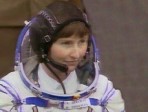 00:29:00
00:29:00
Life in Space
Helen Sharman, the UK's first astronaut, gives a vibrant account of her personal experience of life in space using models and film to illustrate the key scientific concepts involved in spaceflight. Among other things she discusses the way Newton's Th....
More details | Watch now 00:29:00
00:29:00
The Theory of Everything
Are we on the verge of that holy grail of science, a single theory that explains everything from planets to atomic particles, and if we ever get there, will it be the end, or the beginning of physics? Physicists have theories covering everything fr....
More details | Watch now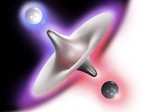 00:29:00
00:29:00
Antimatter
What is antimatter? What does it tell us about the structure of our universe? Can we ever detect it?
More details | Watch now 00:29:00
00:29:00
Mobile Phones – Safe?
A presentation discussing the science of mobile phones and associated radiation. Are mobile phones safe?
More details | Watch now 00:02:00
00:02:00
Millie Dresselhaus
Mildred Dresselhaus was born in Brooklyn, New York and grew up in a poor section of the Bronx. She was a Fullbright Fellow at the Cavendish Laboratory, Cambridge University (UK) in 1951-52 and obtained a PhD at the University of Chicago in 1958. Mill....
More details | Watch now 00:13:00
00:13:00
Cosmic X-ray sources
Riccardo Giacconi , USA was awarded half of the Nobel Prize for Physics in 2002 for 'for pioneering contributions to astrophysics, which have led to the discovery of cosmic X-ray sources.
More details | Watch now 00:15:00
00:15:00
Ivar Giaever
Ivar Giaever won the Nobel Prize in 1973 for his investigations of tunneling in semiconductors and superconductors. Giaever worked on metal thin films and tunneling and took a Solid State physics course. Although he knew nothing about Superconductivi....
More details | Watch now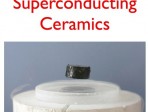 00:06:00
00:06:00
Alexander Müller
K. Alexander Müller shared the Nobel Prize for Physics with J. Georg Bednorz in 1987 'for their important break-through in the discovery of superconductivity in ceramic materials'. At the age of 9 Mller was given a radio (a single vacuum tube receiv....
More details | Watch now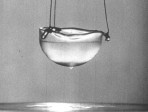 00:15:00
00:15:00
Superfluidity in Helium 3 – Nobel Physics Prize 1996
Together Osheroff and Richardson talk about their different scientific research backgrounds which leads a fascinating discussion on their joint work for the Noble Prize.
More details | Watch now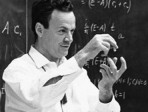 01:18:00
01:18:00
Richard Feynman – The Douglas Robb Memorial Lectures – Part 1
A gentle lead-in to the subject, Feynman starts by discussing photons and their properties.
More details | Watch now 00:25:00
00:25:00
Communication with Space Probes and beyond
The main problems associated with communicating with distant space probes like Voyager 1 are investigated. The role played by diffraction in limiting the amount of power receivable on Earth is discussed. The further problems of reaching a nearby st....
More details | Watch now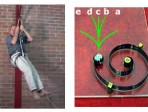 00:10:00
00:10:00
Newton’s laws of motion
F=ma (laws 1&2). Forces come in pairs that add to zero (3). Newton's laws apply in inertial frames of reference. Some common approximations made in applying them.
More details | Watch now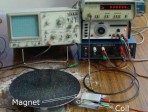 00:08:00
00:08:00
Simple harmonic motion
In simple harmonic motion, displacement, velocity and acceleration vary sinusoidally with time, but with different phases.
More details | Watch now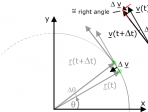 00:08:00
00:08:00
Circular motion
Uniform circular motion: angular displacement and velocity are introduced and centripetal acceleration is determined.
More details | Watch now